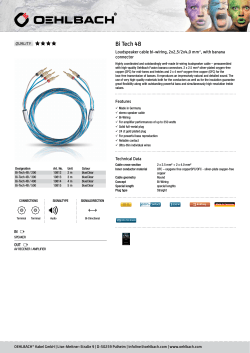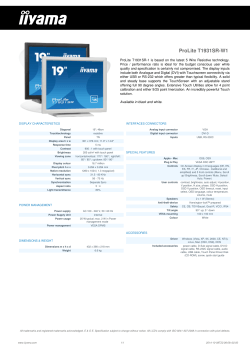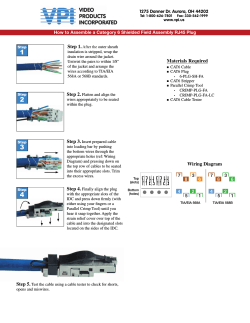
Emerging Trends in Telecommunications-- Business Overview Video Services Forum
Emerging Trends in Telecommunications-Business Overview Video Services Forum October 2001 Presented by Cindy Andreu Creating Convergence The 1939 New York World’s Fair featured the formal debut television broadcast. The receiver, a combination television-radio-recorder-playbackfacsimile-projector set, was way ahead of its time. This suggests a fundamental desire to merge all media into a single entity long before the birth of telecommunications as we know it today. Key Sectors in Telecommunications • Telephone service companies • Broadcast networks • Cable television Industry Subject Regulation • Each sector’s history is filled with federal regulation – Intended to ensure that the masses had cheap access to product offerings – Prevent sector cross-over presumably to fend off monopolies • Finally, in 1996 the U.S. government issued landmark regulation changing the dynamics of this industry. The 1996 Act President Clinton’s Vision: ”We will help to create an open market place where competition can move as quick as light.” • The goal: Accelerate rapid private sector deployment of advanced telecommunications and information technologies • The intent: Facilitate by enabling competition and removing barriers to market entry across all sectors What does Today’s Competitive Landscape Look Like? Key Competition Indicators in Local Telephone • As of 12/2000, new entrant phone lines continue to increase – CLECs report 50% increase in telephone lines from 1999 to 2000 – But CLECs only account for 8% of the pie (Source: FCC) ILEC Lines vs. CLEC Lines (In Millions) CLEC= 8% ILEC = 92% 16.4 CLEC Lines ILEC Lines 177.6 Local Competition--continued • CLEC customers are primarily concentrated in Georgia Iowa Massachusetts New York Texas Illinois Kansas Minnesota Pennsylvania • Accounts for about 50% of total CLEC markets, with each representing at least 10% of the market. (Source: FCC) Local Competition--continued Proportion of Residential vs. Business Customer Mix The proportion of residential to business customers varies significantly between CLECs and ILECs (expressed in percentages) 0.8 0.6 `` Residential 0.4 Business 0.2 0 CLEC (Source: FCC) ILEC Local Telephone Infrastructure Update Capital expenditures = $105 billion from 1995 to 1999 Central office investment: – In 98% or 14,900 central offices have computerized switching – Nearly all offices offer equal access for long distance Local transmission investment: – 80% of transmission paths to customers are linked by copper – 97% of all links tying switching offices together are fiber; up from 60% in 199O (Source: FCC, statistics as of 12/2000) Local Telephone Industry Fact Sheet (As of 12/2000 unless otherwise indicated) U.S. Telephone Households Households with Telephones End-user Lines Service Penetration Percentages: Telephone Video (TV) * DSL * Local Carriers Central Offices * as of 3/01 106,500,000 100,200,000 193,400,000 94.1 % .9 % 2.1 % 257 15,000 Long Distance Providers Long Distance Providers Market Overview • By the end of 2000, 700 companies offered long distance service as compared to 1 in 1976. 2000 Revenue Analysis (In Millions) AT&T $ MCI WorldCom 22,554 Sprint 9,038 Other Long Distance Carriers 30,544 Bell Operating Companies 5,865 Other ILECs 734 Other Local Carriers Total 38,111 1,335 $ 108,181 Long Distance Providers Historical Market Share Analysis for Annual Revenues Year AT&T 1984 1990 1995 2000 68.3% 50.7% 44.9% 35.2% (Source: FCC) MCI/ Sprint WorldCom 3.4% 11.3% 21.4% 20.8% 2.1% 7.5% 8.5% 8.4% All other Long-Dist. Carriers Bell Operating Companies Other Local Telephone Companies 2.0% 8.4% 12.0% 28.2% 17.7% 15.8% 9.6% 5.4% 6.5% 6.3% 3.6% 2.0% Status of FCC Approval for BOC In-Region/InterLATA Service Television Market Place Sector Overview • Broadcast networks and affiliates are consumed with building new FCC mandated DTV channels • In the meantime, Cable has been spending more on programming and stealing audience and advertising revenues from broadcast • Cable is positioning to become a mult-service provider for high speed Internet, video services, Interactive TV and telephone DTV Update • Nearly 70 % of commercial TV stations expect to have DTV signals by May 2002 • 19 out of 20 American homes will have access to at least one DTV signal via over-the-air • Depending upon the channel, viewers may be able see sports or other programming in high definition Trends in Broadcast vs.Cable Viewership shifts: • The most pervasive change over the past 10 years is the shift in viewership from broadcast to cable • Basic cable viewership more than doubled • Cable has taken substantial advertising revenue away from broadcast – Cable represented 11% of TV advertising revenues in 1991 vs. 24% in 2000 Contributing Factors • Overall increase in cable networks from 82 in 1991 to 224 in 2001 • Heavier investment in higher quality programming – Program costs have increased an average of 23% per year over the past five years – Provides more than three times as much children’s programming – Leading source for political and public affairs programming • New business models What’s up with Cable? Infrastructure update as of May 2001: • $50 billion spent on capital expenditures over the past 5 years (Includes FY 2001 projection.) • Heavy investment in infrastructure upgrades and facility improvements provides: – Two-way plant to 60% of all cable homes – 550 MHz to 77% of homes by the end of 2001 (Source: NCTA Web site) Cable Update According to an NCTA press release on 8/13/2001: • Q2 averaged 70K new subscriptions per week for cable modems • 200K residential telephone subscribers were added in Q2 for a total customer base of 1.3 million • There were 15 million business customers by 6/30/01 Cable Industry Fact Sheet U.S. Television Households (1/01) Homes Passed by Cable (12/00) Basic Cable Households (5/01) Cable Modem Homes Passed (E12/01) Cable Modem Subscribers (7/01) Residential Telephone Subscribers (7/01) National Cable Networks (3/01) Service Penetration as Percentages: Cable homes Basic Cable Residential Telephone Cable Modem (Source: NCTA Web site) 102,184,810 97,700,000 69,501,440 81,237,000 5,500,000 1,300,000 224 95.6 % 68.0 % 1.3 % 5.3 % Cable Update Key Players as of 3/01: MSO AT&T Broadband Time Warner Cable Comcast Communications Charter Communications Adelphia Communications Cablevision Systems Total subscribers Subscribers (In Thousands) 15,900 12,800 7,733 6,208 5,723 1,285 49,649 What’s Ahead Emerging Products and Trends Trends in High-Speed Internet Access • In 1999, the FCC found that 98.2 percent of Internet users accessed the Internet through dial-up facilities • Reports from broadband front are one-sided with cable deployments growing more rapidly than DSL Trends in High-Speed Internet Access • Banc of America Securities analyst Douglas Shapiro sees cable modems in 18.8 million homes by 2005 compared to 13.9 million DSL installations • Yankee Consulting predicts that cable modems will hold and even wider advantage over DSL:15.7 million to 10.5 million in 2005 • The FCC projects roughly half of Internet users will still access the Internet through dial-up by 2004 Other Frontiers in Cable • Cable is now poised to fight off direct broadcasters • Digital video offers 4-12 video signals in a 6-MHz channel that used to accommodate 1 analog signal – By the end of Q2, cable had 12.2 million subscribers recovering previously lost customers – Morgan Stanley believes that direct-broadcast subscriber adds will drop from 3.3 million per year to 2 million in 2002 – Paul Kagan projects 43.2 and 48.2 million cable subscribers by 2004 and 2005, respectively (Source: Barron’s and NCTA) Other Frontiers in Cable Video-on-Demand is finally born • Charter Communications, Insight Communications and Comcast have launched services in selected locations doubling the buy rates of older pay-perview. However, these services offer only a meager 350 films to date. – Insight offers DIVA On Demand TV for VOD movies accessed by a remote control and on-screen navigator that includes full VCR functionality (Source: Barron’s and NCTA) Video On Demand Studio Initiatives: • Paramount, Sony Pictures, Universal, MGM and Warner Brothers partner to create an on-demand Web service that will provide theatrical releases to viewers via the Internet. The service is scheduled to start in 2002 or 2003 • Disney and News Corp. have agreed to launch Movies.com in early 2002. Movies will be available in the pay-per-view release window Other Frontiers in Cable Other Enhanced and Interactive TV initiatives available in selected markets: • Interactive Program Guides with many digital TV offerings • AT&T teamed up with WorldGate 2000 in Cedar Falls and Waterloo, IA, to offer e-mail, ecommerce, Internet access and interactive video content/advertising through digital set-top boxes deployed with digital cable (Source: NCTA Web site) Other Enhanced and Interactive TV Services • Charter Communications teamed up with the city of LaGrange, Georgia, in Spring 2000 to offer free Internet-over-TV access providing customers Internet access, e-mail and local information on TV • Cox Communications launched Movies-on-Demand in San Diego using digital set-top boxes and remote controls with VCR ability: pause, fast-forward, rewind • In Honolulu, Time Warner offers iControl Video on Demand ,which instantly delivers pay-per-view and Pizza-On-Demand through Pizza Hut Overview of Interactive TV Products and Markets Emerging Products: • Forrester Research calls ITV the new business model for television and predicts a $20 billion industry by 2004 • Recent product offerings: – OpenTV – Wink Overview of Interactive TV Products and Markets Market Penetration to date: OpenTV 18 million settop boxes deployed worldwide Wink 4 million households Overview of Interactive TV Products and Markets Personal video recorders: Major players are TiVO, ReplayTV, and Microsoft’s Ultimate TV, just launched this year Overview of Interactive TV Products and Markets • Only 300-400,000 units have been sold to-date (189,000 are TiVO units), comparable to adoption of the VCR in the late 1970’s – Analysts believe that entrants have poorly explained the mechanics and benefits to consumers – Often products were priced too high; Replay was priced at $1,499. Motorola will will incorporate this technology into their set-top boxes – TiVO offers several options including a $9.95 monthly subscription or product lifetime subscription of $259.00. TiVO is current being marketed in 4000 retail outlets The Future of Interactive TV Devices IP Telephony • Cable companies are bundling voice services,primarily circuit switched today, with other broadband services. AT&T and Cox are leading the way • Bundled offerings are expected to cut customer churn by 40% • Most MSO’s are waiting for full IP capability to emerge • AT&T and Cox are currently testing IP telephony technology IP Telephony • Time Warner experienced successful trials of IP telephony over fiberoptic networks • Current technical challenges: – Delays in voice signals or loss of voice packets – Commercial equipment delays; missing server that will manage features such as 411, 911, and call forwarding – Technologies to reach critical mass in 2003 and beyond • Benefits: – Estimated to be 40% cheaper to provide and maintain – Leverages existing infrastructure rather building dedicated circuits Advances in Telemedicine New Uses for Video • Ambulance Telemedicine – U. of Maryland pilots project that integrates video images, audio, vital signs and ECGs to be transmitted from within a moving ambulance to land-based workstations where they are used to manage the patient – Project has been underway for 18 months with over 12 patients – A similar pilot is also underway in Las Vegas Advances in Telemedicine • Tele-Home Health Nursing – Using a regular phone line and an MCI videophone customized by American Telecare, Kaiser Permanente staff can have a video visit from a healthcare center with a patient at home – Breathing is monitored on another line using headphones while the patient’s spouse moves the stethoscope around the patient’s body – Preliminary trial results in Sacramento indicate nurses can contact up to 15 patients per shift as opposed to 6 on face-to-face visits traveling from home to home Questions? Creating Convergence Today, wireless phones, personal computers, PDAs, and televisions are taking on one another’s functions. Content can be sent to many platforms over multiple distribution channels. Creating Convergence For certain, three elements of convergence are emerging: – Content:- combination of audio, video, data or just data – Platforms:- PC, TV, Internet appliance or game machine – Distribution:- how content gets to your platform and they are powerfully intertwined. Managing the process to Convergence The challenges: • Standard technologies and architectures must be adopted to ensure interoperability • Content encryption tools must be developed for copyright protection • Profitable investment in distribution capacity robust enough for two-way communications of various media Managing the process to Convergence • We can expect to use multiple devices most likely connected by the Internet. • Consumers, with new technology choices, will demand content in one source, received on a single device, delivered by a single connection. • Although this still seems far off, the outcome has already been given a name… Emergence –What defines telecommunications today? –Emergence since the 1996 Act? –What’s ahead? Telecommunications Tele:- distant or at a distance + Communications:- an act or an instance of transmitting information; the technology of transmission of information = Telecommunications:- Communications at a distance as by cable, radio, telephone or television Economic Factors Affecting Competition • Legacy long-distance subsidies (roughly $30 billion annually) produce backward economics. • Its very difficult to build profitable models that require infrastructure. The existing Bell network is valued at more than $270 billion, not feasible to duplicate • No elasticity in voice. Revenues often suffer when prices are lowered because demand does not grow. Economic Factors Affecting Competition The problem: • For example, author Steve Rosenbush cites in his book, Telecom Business Opportunities: – Building a network from scratch including switches, transmission, equipment and phone lines can run as much as $4,000 per customer – The FCC reports consumer payments to local telephone companies average $360 annually – At that rate, it would take more than 11 years to breakeven Business Opportunities with DTV Datacasting: • Households – games, video, Internet, or ticker services to TV • Business – sending data to businesses without using T1 lines
© Copyright 2025









